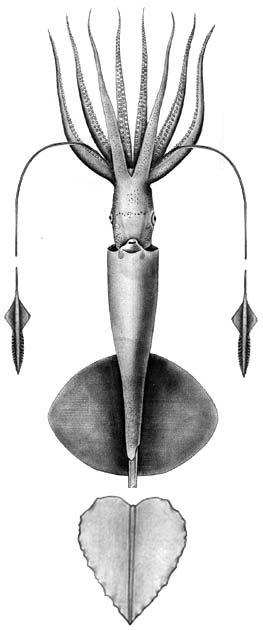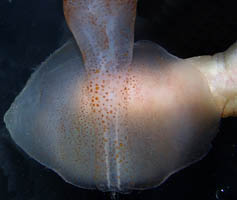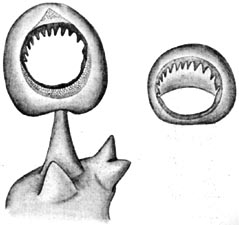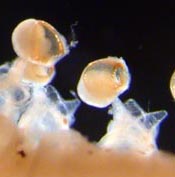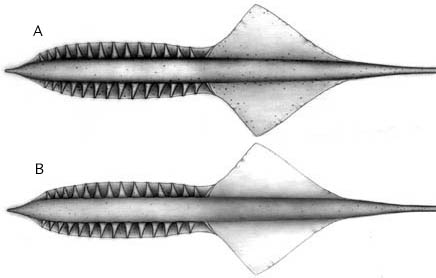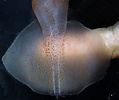Grimalditeuthis
Grimalditeuthis bonplandi
Richard E. Young and Clyde F. E. RoperIntroduction
Grimalditeuthis bonplandi is very gelatinous and contains vesiculate tissue in the head, arms and mantle. It is generally Chiroteuthis-like in appearance (long neck, body and fin shape) but is distinguished by subequal arms and fusion of each funnel-mantle locking apparatus. Only scattered chromatophores are present, and the eyes are small. This species is infrequently captured but seems to have a world-wide distribution in tropical to temperate seas.
Diagnosis
A chiroteuthid ...
- without suckers on clubs.
- with funnel locking-apparatus fused to mantle.
- without photophores except on arm tips in mature (?) females.
Characteristics
- Arms
- Arms approximately subequal in length, gelatinous.
- Sucker base with three conical papillae (unique character).
- Protective membranes absent.
Figure. Oral view of large arm III sucker, stalk and base, with inner ring at right, G. bonplandi, 89 mm ML, female, off Southern California. Drawing from Young (1972).
- Tentacles
- Club divided into two portions by symmetrical protective membranes.
- Suckers absent from clubs.
Figure. Tentacle-clubs of G. bomplandi. A - Aboral view. B - Oral view. a single intact tentacle was found on a specimen taken from the stomach of the fish Alepisaurus ferox (courtesy of Lourdes Burgess). The tentacle club lacked suckers and showed no indication that suckers or sucker stalks were ever present as the skin was intact. Drawings by A. D. Hart
- Head
- Olfactory organ located lateral to base of funnel (i.e., anterior to collar at posterior end of neck).
- Beaks with distinctive appearance.
- Funnel
- Funnel valve present.
- Funnel fused to mantle at each funnel-mantle locking-apparatus (head not fused to mantle in nuchal region).
- Photophores
- Absent accept at the arm tips of mature (?) females (See "More details ...").
- Tail
- Two fin-like "floatation devices" (= secondary fins) arise from tail.
Comments
More details of the description can be found here.The function of the suckerless club is unknown. Tentacle stalks are very thin, fragile and almost always broken off in capture.
This species also has a very characteristic pattern of chromatophores on the head. A line of chromatophores passes across the ventral surface of the head between the anterior ends of eyes; another line runs along the neck from each olfactory papilla anteriorly to each eye, then anterior to each eye along the brachial pillar, terminating at the base of the arms.
Nomenclature
Joubin (1898) described a second species, G. richardi based on the presence of photophores on the tips of the arms. Pfeffer (1912) synonomized the two and this was supported by Young (1972) and Nesis (1982).
Life History
The doratopsis was first described by Chun (1910) as Doratopsis sagitta. A growth series of the paralarvae was described by Young (1991), and can be found here on the next page. The early doratopsis stage is similar to that of other species in the family. The older doratopsis shows many of the features of the subadult including the distinctive chromatophore pattern and the small eyes.
Distribution
Vertical distribution
A small number of captures off Hawaii (Young 1978) included three small squid from the upper 350 m that probably had not descended from the shallow paralarval habitat and five squid from depths greater than 700 m.
Figure. Vertical distribution chart of G. bonplandi, Hawaiian waters. Captures were made with both open and opening/closing trawls. Bars - Fishing depth-range of opening/closing trawl. Circle - Modal fishing depth for either trawl. Blue color - Night captures. Yellow color - Day captures. Chart modified from Young (1978).
Geographical distribution
The type locality is 29° N and 39° W in the North Atlantic. It is known from the tropical and subtropical North Atlantic and the tropical and temperate North Pacific (Nesis, 1982).
References
Joubin, L. 1898. Observations sur divers Cephaloppodes. Quatrieme note: Grimalditeuthis Richardi Joubin 1898. Bulletin de la Societe Zoologique de France, 23: 101-113.
Pfeffer, G. 1912. Die Cephalopoden der Plankton-Expedition. Ergebniss der Plankton-Expedition der Humboldt-Stiftung. 2: 1-815.
Verany, J. B. 1839. Memoire sur six novelles especes de Cephalopodes trouvees dans la Mediterranee a Nice. Memoire della Resle Accademia della Science de Torino, series 2, 1: 91-98
Young, R. E. 1972. The systematics and areal distribution of pelagic cephalopods from the seas off Southern California. Smithson. Contr. Zool., 97: 1-159.
Young, R. E. 1978. Vertical distribution and photosensitive vesicles of pelagic cephalopods from Hawaiian waters. Fish. Bull., 76: 583-615.
Young, R. E. 1991. Chiroteuthid and related paralarvae from Hawaiian waters. Bull. Mar. Sci. 49: 162-185.
Title Illustrations
| Scientific Name | Grimalditeuthis bonplandi |
|---|---|
| Location | Off Southern California |
| Reference | modified from Young, R. E. 1972. The systematics and areal distribution of pelagic cephalopods from the seas off Southern California. Smithson. Contr. Zool. 97:1-159. |
| Sex | Female |
| View | Ventral |
| Size | 89 mm ML |
| Copyright | © Richard E. Young |
| Scientific Name | Grimalditeuthis bonplandi |
|---|---|
| Location | Hawaiian waters |
| Comments | The photograph shows the delicate, translucent nature of the fin and its light pigmentation. A human finger can be seen behind the fin. |
| Body Part | Fins |
| View | Ventral |
| Copyright | © Richard E. Young |
About This Page
Richard E. Young
Dept of Oceanography
University of Hawaii
Honolulu, Hawaii 96822
USA
Page copyright © 1999 Richard E. Young and
Citing this page:
Young, Richard E. and Roper, Clyde F. E. 1999. Grimalditeuthis . Grimalditeuthis bonplandi . Version 01 January 1999 (under construction). http://tolweb.org/Grimalditeuthis_bonplandi/19463/1999.01.01 in The Tree of Life Web Project, http://tolweb.org/





